Advances Received
Advances Received are a part of the documents of the Sale module. The book of advances received is used to issue the advances to customers and to their records.
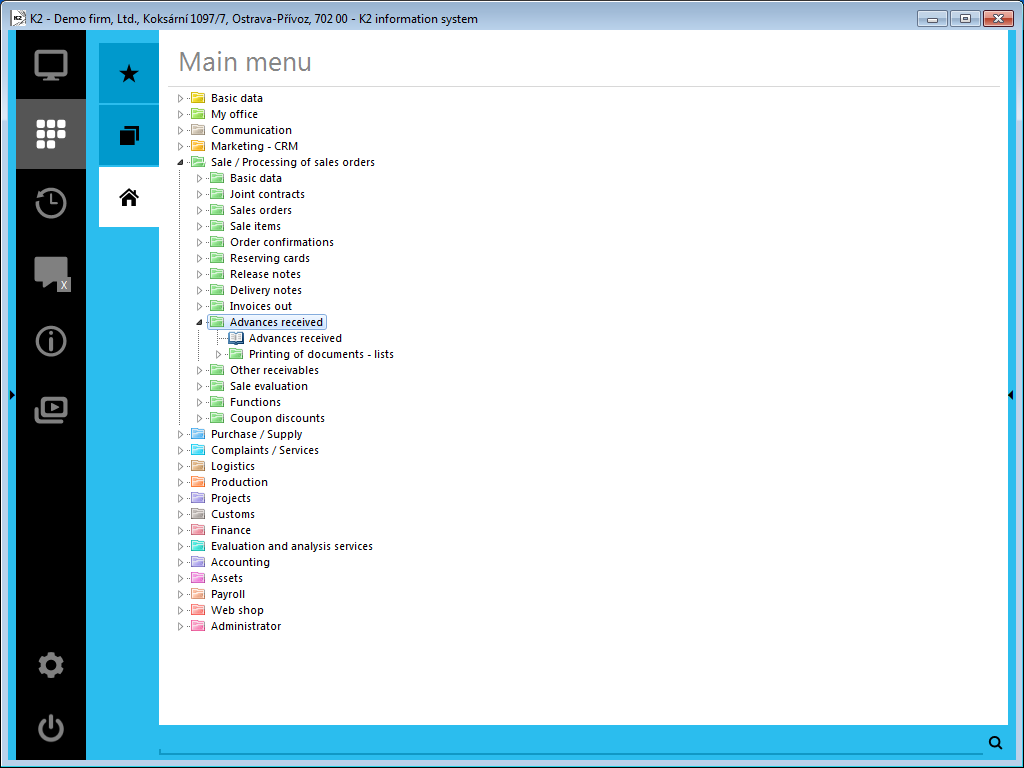
Picture: The open menu of the Sales / Processing of sales orders - Advances Received module
Advance amount and VAT rate are entered on the 1st page of a document. The additional VAT rates can be entered in the items on the 2nd page of an advance.
The individual advances can be attached to a Sales order, or it is possible to create one or more advances to the specific Sales order. Such advances are called Advances to sales order. Advances without this link are seen as Advances to customer.
Information about the created advances to the given Sales order are available right on the Sales order:
- on the 5th page of a Sales order in the Advances received tab.
The Advances can be switched to the Tax document state. It is the another significant difference of the advances from the other Sales documents. A confirmed paid tax advance can be switched to this state and advance in this state enters to the VAT return. It is not possible to edit, cancel or pay a tax document.
The advances are matched with payments, like the other documents of the Sale, i.e. as the payment we understand matched cash voucher or bank statement; by settlement we mean a matched bank statement. The advances can enter to the Payment calendar (if the Create item of payment calendar client parameter is set).
The paid advance is ready for deducting on the invoices which the operator executes on the 2nd page of an invoice. There is a table, where the deductions of advances on the current invoice are displayed, in the lower part of the form. By Insert key you can add deduction of other advance to the table, when IS K2 offers the non-deducted items of advances, which are available. Or you can use the Apply adv. linked w. sales order, Apply adv. linked w. customer buttons, by which the IS K2 offers not only the unused items of advances but also the amounts for the deduction up to the maximum possible amount.
Until the advance isn't switched to the Tax document status, it is deducted as no tax advance regardless of the fact, whether the field VAT is checked on the document and VAT on the document is quantified. During deduction of this advance on the invoice, the advance will be deducted with a VAT rate and a tax type entered in the Client parameters on the 3rd page in the field VAT rate for deduction of no tax advance and Tax type for deduction of no tax advance .
If the Allow to apply advances from the same book only checkbox is set on the 3rd page of the Client Parameters, then only advance, which has been issued in the same book, can be deducted on the invoice. Otherwise it is possible to deduct the advance issued in any book.
Advances Received Book

Picture: Advances Received book
Advance received document
The first page of advances received serves to display the identification and basic data about the advance and some other information such as payment method, date of issue, maturity date etc.
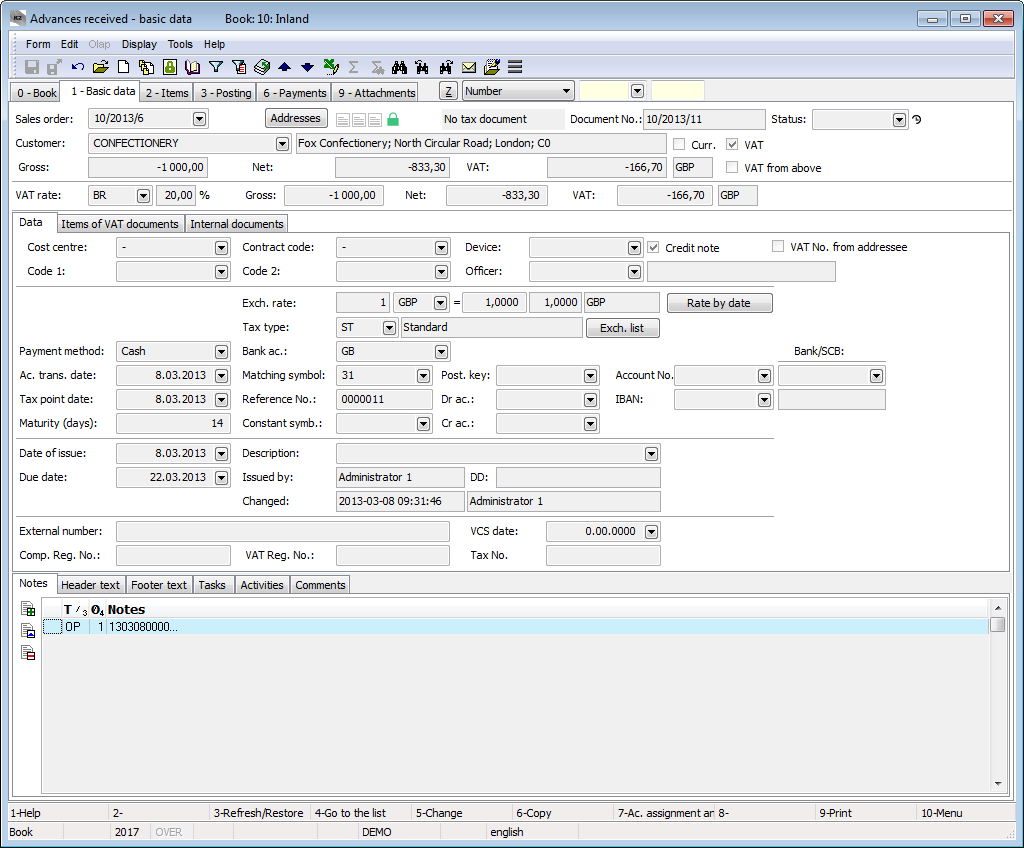
Picture: Advances Received - 1st page
Fields Description:
Sales order |
The field serves for definition of the number of a sales order to which the Advance received is created. If an advance is issued to a customer only, the field remains empty. |
Addresses |
The button to display an addressee and a superior firm. For further information see the Addressee chapter. |
No tax document |
Information about the advance status from the tax perspective. In the case that the advance received is confirmed and paid and the VAT field is checked, it is possible to switch it into the Tax document status. |
Document No. |
Book, Business year and number of the Advance received. |
Status |
Field for selection from a code list. This field enables to filter documents according to the selected status by a user. |
Customer |
A business partner name that is inserted by selection from the Suppl./Cust. book. |
VAT Rate |
The VAT rate which the advance is issued for. A selection from the Taxes code list. |
Gross |
Gross amount in a currency of advance. |
Net |
Net amount in a currency of advance. |
VAT |
VAT amount in a currency of advance. It is not possible to edit this field. |
|
If an advance is in a foreign currency, the amount in a currency of a client are also displayed under the amounts in a currency of advance. |
Currency |
The flag marks that the advance is issued in a foreign currency. |
VAT |
If the field is checked, the advance includes the tax. |
VAT from above |
It sets the gross price in items as default. Then the VAT is calculated by a coefficient that is set in the VAT rates book and and Net value is calculated as a difference between Gross and VAT amounts. |
It is possible to assign the random types and kinds of the notes to the Advances, eventually it is possible to use the Header text or the Footer text. Further description of work with the notes is stated in the Basic Code Lists and Supporting Modules K2 – Notes chapter. The Tasks and Activities tabs are also available. The work with tabs is described in the Tasks - document's tab and Activities - document's tab chapters.
The Data tab contains the basic information from the document header.
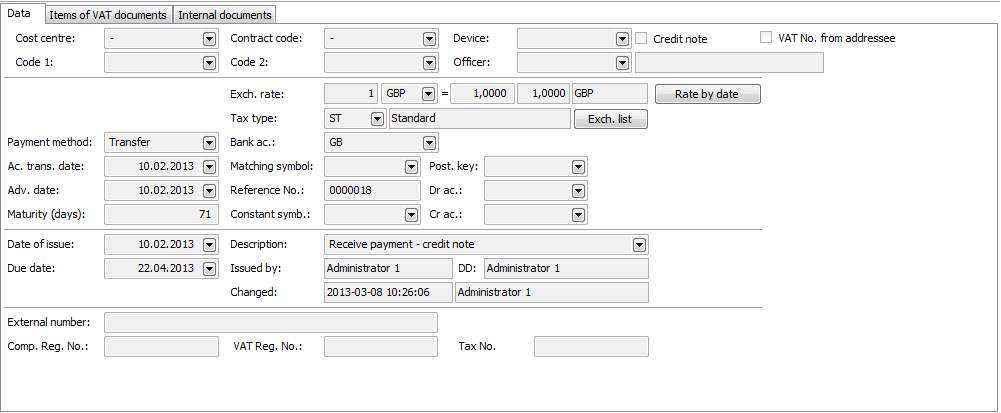
Picture: Data - Advances received (1st page)
Fields Description:
Cost Centre, Contract Code, Device, Article Code, Code 1, Code 2, Officer |
Data that serve for the sorting the activities of a company. Further description is stated in the Basic Code Lists and Supporting Modules K2. |
Credit note |
The issued advance will be indicated as a credit note by checking this field. |
VAT No. from Addressee |
If the field is checked and the Advance is included in Summary Report, the VAT Reg.No. will be taken from the firm entered in the Addressee. |
Exchange Rate |
The document currency and the exchange rate for a recalculation to the domestic currency. The exch. rate, that is valid to the date of issue, is selected. If the Invoice exch. rate according to ac. trans. date parameter is set in the Client parameters, the exch. rate on the ac. trans. date is added. After the payment or the revaluation of a document, this field can not be edited any more. |
Rate by date |
This button enters an exchange rate from the Exchange List valid on the date depending on the Exchange rate according to accounting transaction date parameter. |
Tax type |
Determination how it will be treated with the value added tax. By selecting from the selection menu indicate whether it is an inland Advance (TU - Inland), Export, Import, etc. |
Exch. list |
This button opens the preview of exchange list of the given currency and sets the light indicator on the rate valid on the date of issue of an invoice. |
Payment Method |
The method of the advance payment. Note: The Payment Method can influence the Advance rounding off. For the further description see the Advances rounding chapter. |
Bank account |
Bank Account of "our" company, to which the payment should be sent. If the Uniform bank connection for inv. out client parameter is set, the bank account from the customer in the own company will be added, otherwise the bank account set on the Suppl./Cust. card will be added. |
Ac. transaction date |
Ac. transaction date enters into the accounting. |
Matching Symbol |
Matching symbol for accounting documents (see the Accounting - Matching Symbols) chapter. |
Posting key |
By selecting the posting key you define, how the document will be posted. It is added from the Book of sale. |
Advance Date |
Advance Date enters into the VAT Return. If the Advance Date is zero, the document does not enter into the VAT Return. |
Reference Number |
Field for a reference number of the advance received. It can be create automatically according to the setting in the Books of Sale. The program warns us of the possible duplication of a Reference symbol. |
Dr account, Cr account |
Dr and Cr account for advance. This field is automatically filled with the account according to the setting in the Book of sale. If the fields are not filled in the book of sale, the accounts are filled from the Suppl./Cust. card. |
Maturity (days) |
Number of Maturity Days. |
Constant Symbol |
A Constant Symbol supplemented by the selection from the menu table (F12). |
External number |
External number (60-character text). |
Comp. Reg. No. |
Comp. Reg. No. of a customer. If it is not entered, a Comp. Reg. No. from the Customer card is applicable. |
VAT Reg. No. |
VAT Reg.No. of a customer. If it is not entered, a VAT Reg. No. from the Customer card is applicable. |
Tax No. |
Tax No. of a customer. If it is not entered, a Tax No. from the customer card is applicable. |
Date of Issue |
The date of issue of the document. It is automatically update when switching into a tax document state. |
Due date |
Due date of a document. According to the Derive due date from Accounting trans. date client parameter settings, the Due date is automatically assigned by adding the number of Maturity Days to the value of the Date of Issue field or to the Acc. trans. date field. If there is Floating maturity checked on the Payment conditions tab on the Suppl./Cust. card, then the Due date is filled according to the Month shift and Days from beginning of month values. |
Description |
It is possible to insert a description manually or from the selection menu into this field. |
Issued by |
Name of an employee who has issued the document. |
DD |
Name of an employee who has switched an advance into a tax document. |
Changed |
The date and name of an employee who has made the last change of a document. |
It displays the VAT documents items, in which the Invoice In is entered.
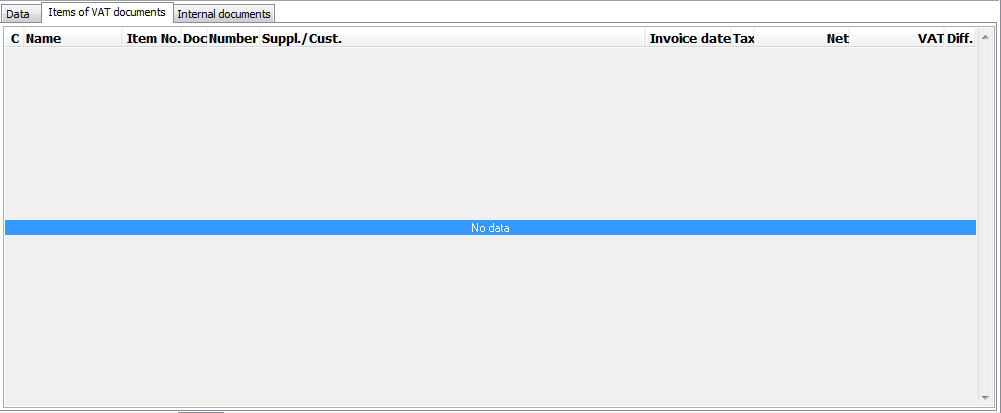
Picture: Advance received - 1st page - Items of VAT documents tab
Internal documents, in which an advance received is stated in the heading of an internal document in the Document field, are displayed.

Picture: Advance received - 1st page - Internal documents tab
The advance items can be inserted in the upper part on the 2nd page of a document.
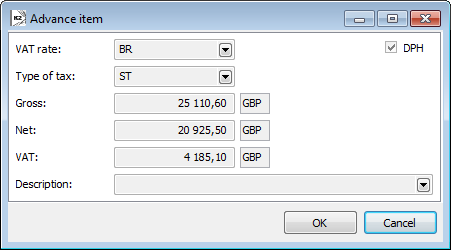
Picture: Advances received - 2nd page - Advance item form
Fields Description:
VAT Rate |
VAT rate of an advance item. A selection from the Taxes code list. |
VAT |
VAT flag, which determines, whether it is an item incl. VAT or excl. VAT. Upon enable and disable DPH flag in the header of an Advance, DPH flag on all items will be automatically updated. |
Type of tax |
Tax type of an advance item. A selection from a Tax type code list. |
Gross |
Gross amount in a currency of advance. |
Net |
Net amount in a currency of advance. |
VAT |
VAT amount in a currency of advance. It is not possible to edit this field. |
Description |
Description of an item. It can be edited or selected from a Description code list. |
The invoices, on which the advance has been deducted, are displayed in the bottom part of the 2nd page of a document.
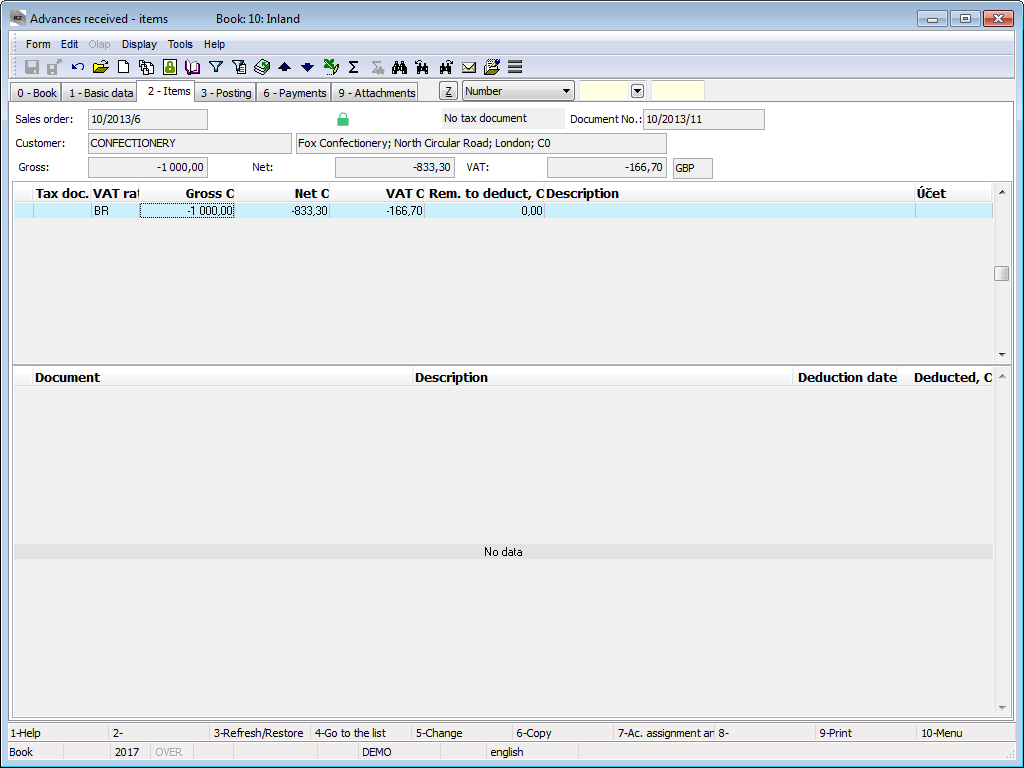
Picture: Advances received - 2nd page
A Received Advance contains the Debit side and the Credit side directly in the heading of the document. Both sides can be predefined in the Sale books, thereby you can ensure the inserting Debit and Credit accounts in all new created Received Advances in a book. After pre-definition in the Sale books, you can select the most frequently used accounts for billing the Received Advances. In case that you will record an advance that you charge to the different accounts, in a book, you can change the accounts immediately when creation the Advances, eventually later by the Change Account Distribution function in bulk(Form / Bulk Actions / Change the Account Distribution).
Identically as the accounts, you can also insert an Account Distribution into a Received Advance. By this Account Distribution, the Advance will be charged. You can also predefine the Account Distribution in the Books of Sale, you can change a predefined Account Distribution simultaneously as it is described above at the Credit and Debit accounts, it means by the Change Account Distributionfunction (Form / Bulk Actions / Change the Account Distribution).
A Received Advance that has defined a Credit and a Debit side account and an Account Distribution and it is also confirmed, it is ready to post. Only the confirmed Advances should be posted.
The 3rd page of the document is used to post the received advances. The lower part of the page is designated to book the document.
Note: Closer description of the booking and settlement is stated in the Accounting - Account assignment and Settlement chapter.
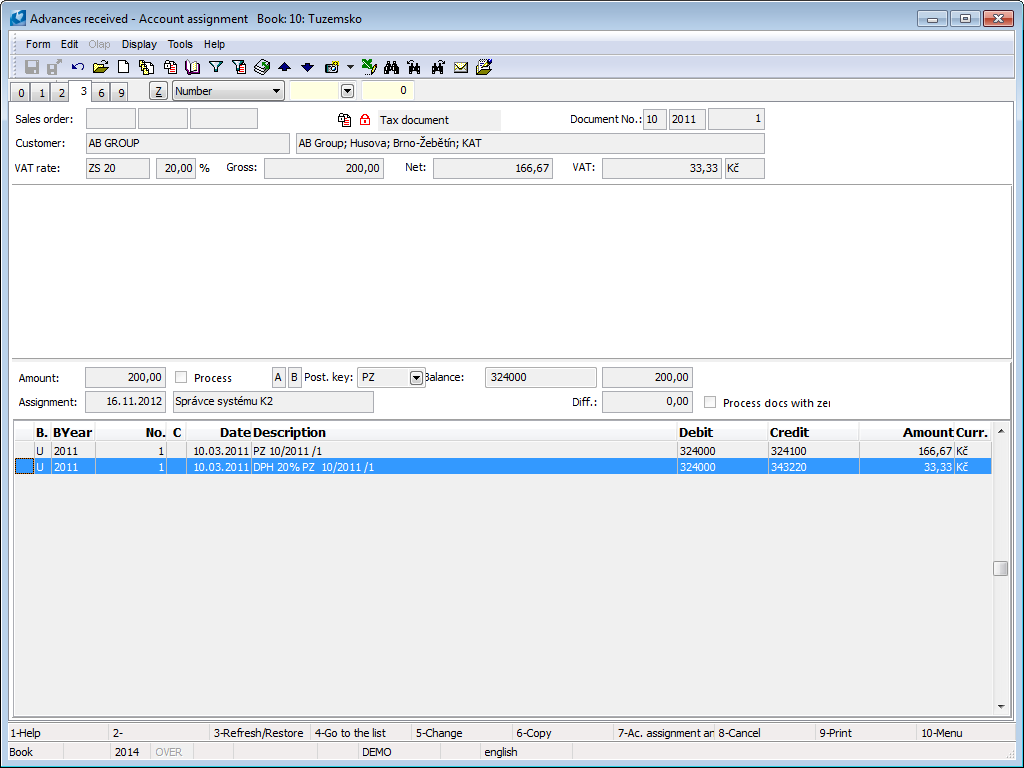
Picture: Received Advances - 3rd page
You can post the Advances in Bulk. Create a filter of the confirmed and paid Advances per a business year in which you want to post the Advances and post them standardly in bulk (Ctrl+F7 keys over the selected Advances).
If the Tax Document status will be changed on a posting document, the Posting and Settlement checkbox are always unchecked. It is necessary to charge the document again.
Standardly, you can charge a Received Tax Advance as follows:
Net price |
a Debit Side account from a Received Advance / a Credit Side account from a Received Advance |
the Amount of VAT |
a Debit Side account from a Received Advance / 343 |
Standardly, you can charge a Received Non-Tax Advance as follows:
Gross price |
a Debit Side account from a Received Advance / a Credit Side account from a Received Advance |
The user is enable to monitor the facts related to status of payment of Advance, on the 6th page of Advance Received - whether it is paid in full or partially, Due date, delay, or information about the specific payments (in the lower part of 6th page). This page is displayed only in Browse mode (it is not accessible in Change mode or in New document).
Upon the payment of an Advance Received, the Ac. trans. date and the Advance date are automatically changed on the document according to the Date of Issue of the Payment. If the Set "tax doc." status on advances when paid in full field is checked in the Book of Sale, the Tax Document status is automatically set when the Received Advance is paid in full.
If the Advance is in the Tax Document status, it is not possible to match the next payment with the document. It is also not possible to undo the match of the current payment.
An advance and a payment do not have to be in the same currency.
If the Advance is in a foreign currency, only one payment can be matched on it.
If an Advance is inserted on a Cash Voucher or a Bank Statement manually, and the Advance has a different exch. rate than the payment, the message will be displayed: "Do you want to change exchange rate of the advance according to the document exchange rate?". After the approval, the Exchange Rate on the Advance will be automatically changed according to the Exchange Rate of the Cash Voucher or Bank Statement. If you answer "No", it will not be possible to save the payment.
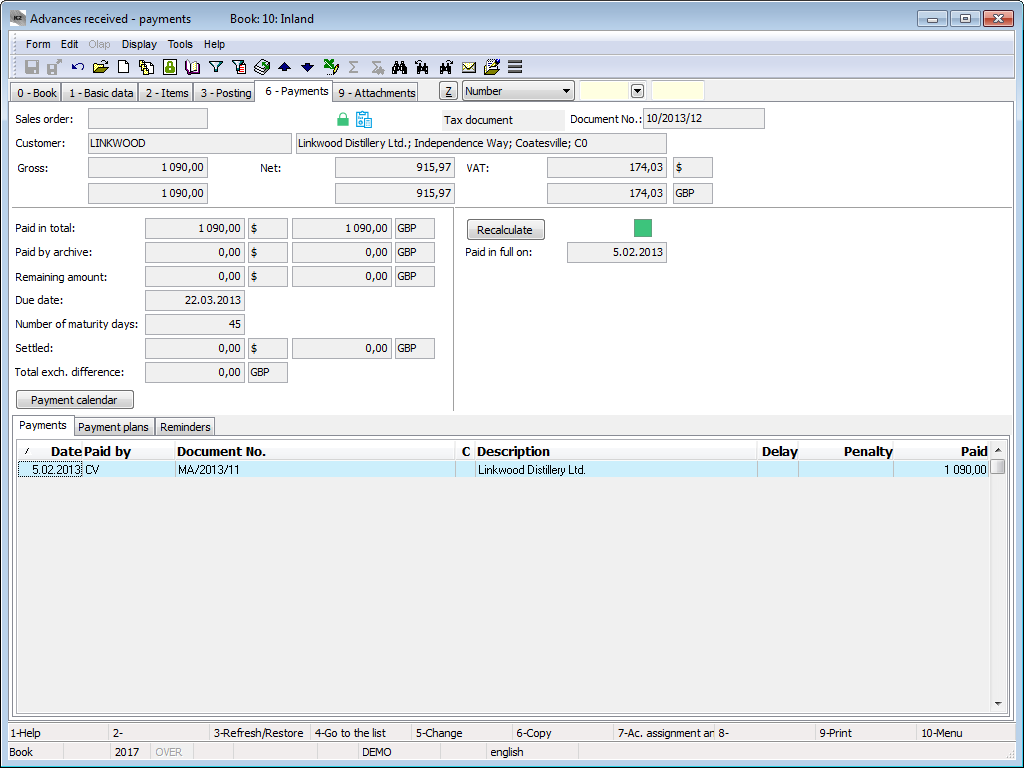
Picture: Advances received - 6th page
Fields Description:
Paid in total |
The total amount which has been already paid. |
Paid by archive |
The amount paid by the documents, which have been already moved to an archive. |
Remaining amount |
The amount that remains to pay. |
Recalculate |
The Recalculate button executes a recalculation of the payments to the invoice. The recalculation can be also run by using Ctrl + F3 key combination on the 6th page of an advance. If there is an exclamation mark next to the button, the payments on the 6th page are not loaded correctly - it is necessary to run the payments recalculation. |
Due date |
Due date. |
Number of maturity days |
Number of maturity days. |
Total exch. difference |
The total exchange difference. |
Paid in full on |
The actual date of the advance received payment. |
Payment Calendar |
The button serves to switch over the 1st page of the corresponding items of Payment Calendar. |
The amounts in a currency of a client are displayed on the documents in a foreign currency except the amounts in a currency of advance.
The bottom part of the 6th page is divided into 3 tabs:
- Payments,
- Payment plans,
- Reminders.
The individual payments of an Advance are displayed in the Payments tab. After pressing the Enter key in Browse mode on a specific payment, the 2nd page of a Bank Statement, a Cash Voucher, an Internal Document eventually a Banker's order, by which the payment has been executed, will be displayed. In the bank statement (Cash Voucher, Internal Document or the Banker's Order), the light indicator will be positioned on an item which corresponds to the Advance's payment.
You can insert Items, which will indicate the plans of a Payment Calendar, by pressing Ins key in the Plans of Payments tab in the Change mode (switch into Change mode directly on 6th page).
There are individual Reminders, which have been issued on an Advance, displayed in the Reminders tab. By pressing Ctrl+Enter keys, you can switch into the book of Reminders, where the light indicator is positioned on a specific Reminder.
External documents can be inserted and references can be assigned to documents in K2 IS on the 9th page of the received advances. Further description with the ext. documents and the documents is stated in the chapter Basic Code Lists and Supporting Modules K2 – 9th Page.
The bulk actions are executable over the evaluation filter or over the records indicated by asterisk.
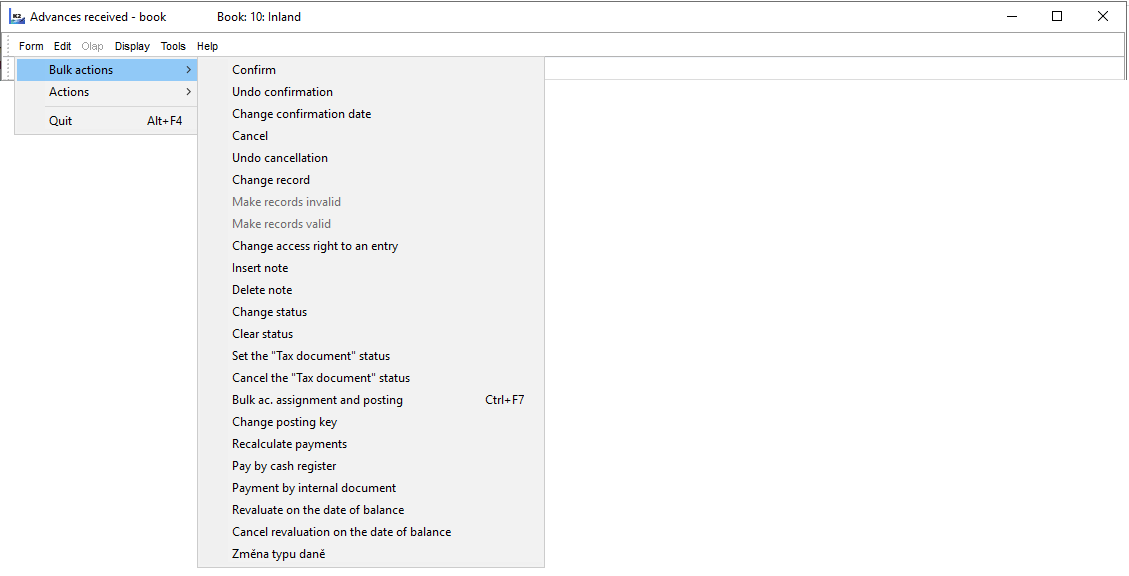
Picture: Functions of Advances Received Module Menu
Actions Description:
Set the Tax Document status |
The function sets the Tax document status on the paid Advances with the checked VAT flag. |
Cancel the Tax Document status |
The function cancels the Tax document status on the Advances, which have not been deducted yet. |
Recalculate payments |
The function for the mass recalculation of the payments of the Advances Received. |
Pay by cash register |
It executes automatic payment of advances by cash register. Further description is stated in the Invoice payments - Automatic payment by cash register and internal document chapter. |
Payment by internal document |
It executes automatic payment of advances by internal document. Further description is stated in the Invoice payments - Automatic payment by cash register and internal document chapter. |
Revaluate on the date of balance |
It revaluates the invoices on the date of balance by internal document. The further description is stated in the Accounting - Revaluation on the date of balance part. |
Cancel revaluation on the date of balance |
It cancels a revaluation on the date of balance. The further description is stated in the Accounting - Revaluation on the date of balance part. |
Functions over Advances Received
Description of the functions:
Alt+F3 |
It switches the Advance into the Tax document status. The Advance, which has the checked VAT field, is confirmed and paid and which has not been deducted on an Invoice yet, can be switched into this status. |
Ctrl+F3 |
It cancels the Tax Document status on 0th to 3rd page in Browse mode. This status can be deleted only if the Advance has not been deducted on an Invoice. It activates the Recalculate payments for the Advance Received on the 6th page in Browse mode. |
Shift+F2 |
It activates the form for a change of the Invoice date (in the book and on the 1st page in Browse mode). It is executable above the credit notes only. Automatic payment by cash register. This function can be run only in Browse mode on the 6th page of an Advance received. |
Shift+F3 |
Automatic payment by internal document. This function can be run only in Browse mode on the 6th page of an Advance received. |
Shift+F5 |
A form for creation of reminders is open on the 0th page. |
Alt+Shift+F3 |
It activates the function, that processes a partially paid or overpaid Advance, on 0th page in Browse mode - it increases or decreases amount of the Advance according to the payment or it divides the Advance into two advances. See the further description in the Partially Paid / Overpaid Advance chapter. |
Ctrl+Alt+M |
If the advance has been issued in a foreign currency, it may be displayed in the company currency by pressing these keys. The amounts on a document will be recalculated and the setting of the Currency flag will be changed. |
Ctrl+Alt+F5 |
The function enables to select a Status of a document. |
Methodologies of Advances received
Process during the receiving an advance from a customer
Introduce the work with an advance received step by step within the business case.
On the basis of agreement, the Call of Payment, in which the amount, which we require to settle, is specified, is issued to the customer. An Advance Received will be created in the K2 IS.
If there is also a Sales Order created to the given agreement, then an Advance Received is created directly to this Sales Order. First find the appropriate Sales Order, then switch to the 2nd page and press New Advance to sales ord. button. A new Advance Received with the pre-filled data from the Sales Order will be created, the amount of an advance will be a total advance amount reduced by Advances, which have been issued to the given sales order so far. Buttons on the 2nd page of a sales order are accessible in the Change mode and in the Browse mode. It is not possible to create a new advance to a confirmed sales order.
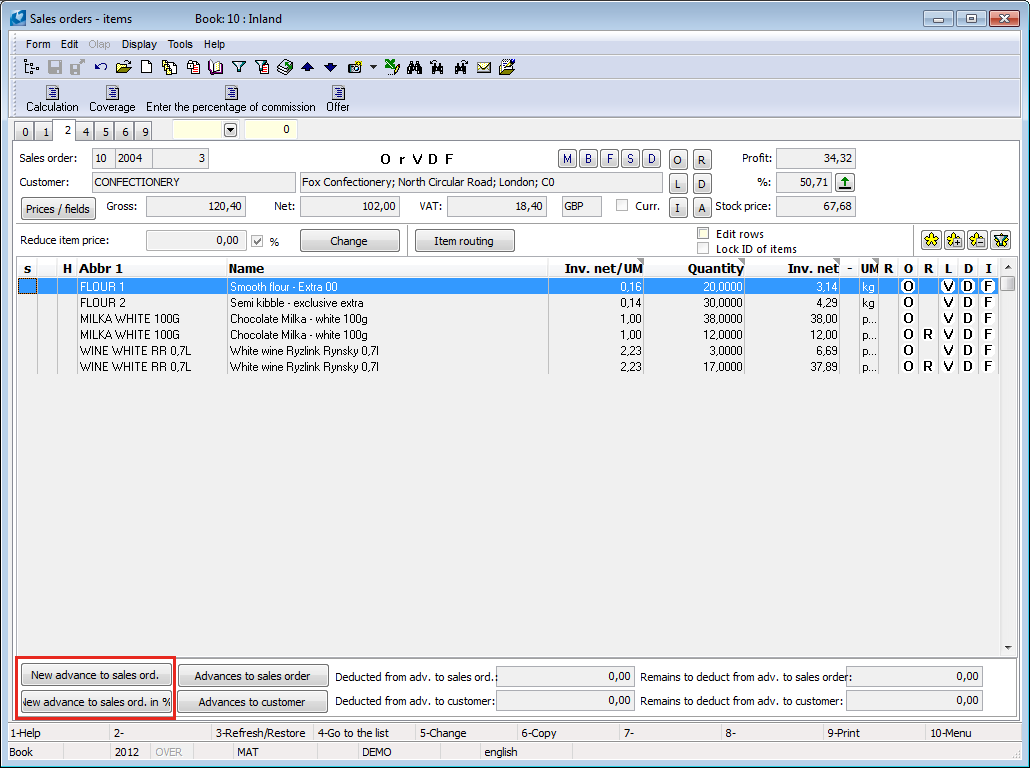
Picture: Sales Order - 2nd page
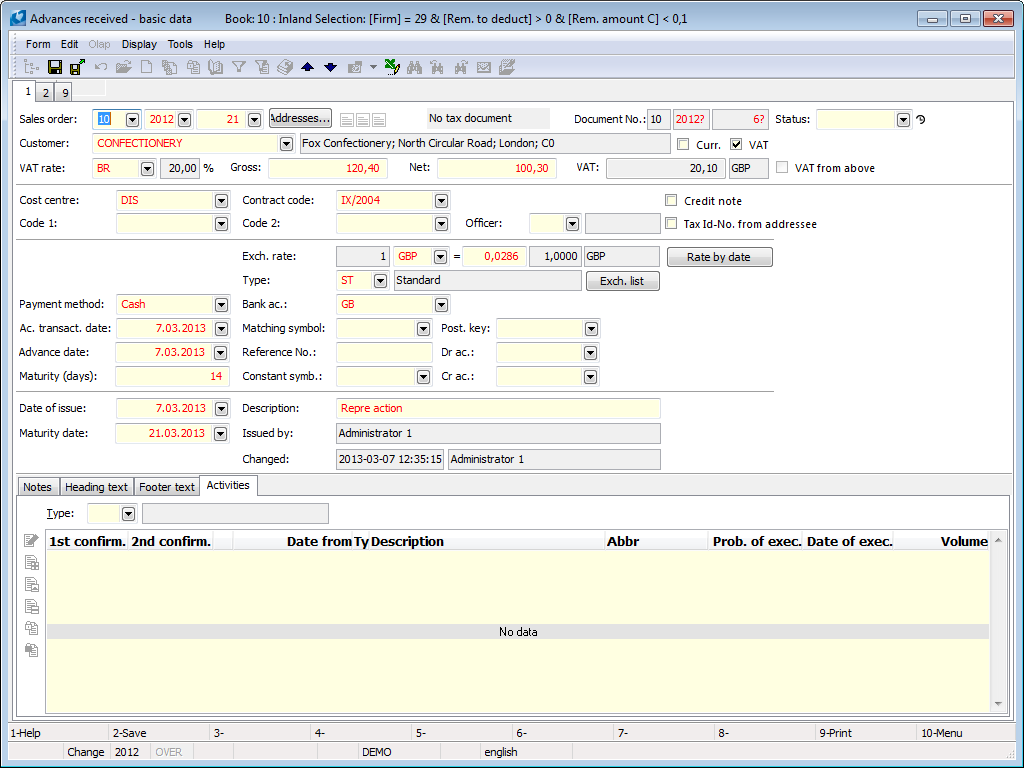
Picture: The pre-filled advance
Or on the 2nd page of the sales order it is possible to use the New advance to sales order % button, which makes the calculation of the advance amount easier. For example, in the agreement it is established that the customer will pay in advance 60 % of the sales order. Create an advance directly in the sales order by the New advance to sales order % button and in the displayed form enter "60". The calculated amount of a future advance will be displayed on the form. After pressing the OK button, a new advance received with pre-filled data from the sales order and with the amount, which equates to 60 % of the amount of the sales order, will be created.
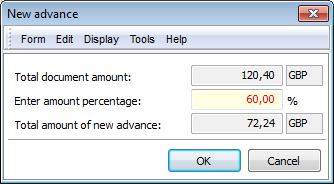
Picture: Entering the percent of sales order amount
A new advance received created by the buttons (described above) remains in the Change mode as long as you don't fill all the required data and further don't save it by F2 key and don't confirm it. So created advance received will be also matched with the appropriate sales order.
In the cases, when you require to settle some amount in advance, but you are not able to exactly specify the sales order, to which the advance will be bounded, create a call for payment directly in the Advances received book. A new document will be created in the book by pressing Ins key and by filling the needed data. Save the document by F2 key and confirm it. So created advance received is free, resp. advance to customer. But the option to additionally pair the advance with the current sales order is left (in the Change mode of the advance received enter a book, a period and a number of the sales order). The other option how to match a free advance to a sales order is by using Alt+F5 keys combination. This function serves for linking inferior document with superior document and the function is available on all pages of the document. By Alt+F5 keys a table menu, which contains a list of sales orders, is activated and by Enter key the proper document is selected.
For printing the call for payment, the report Advance Received is ready.
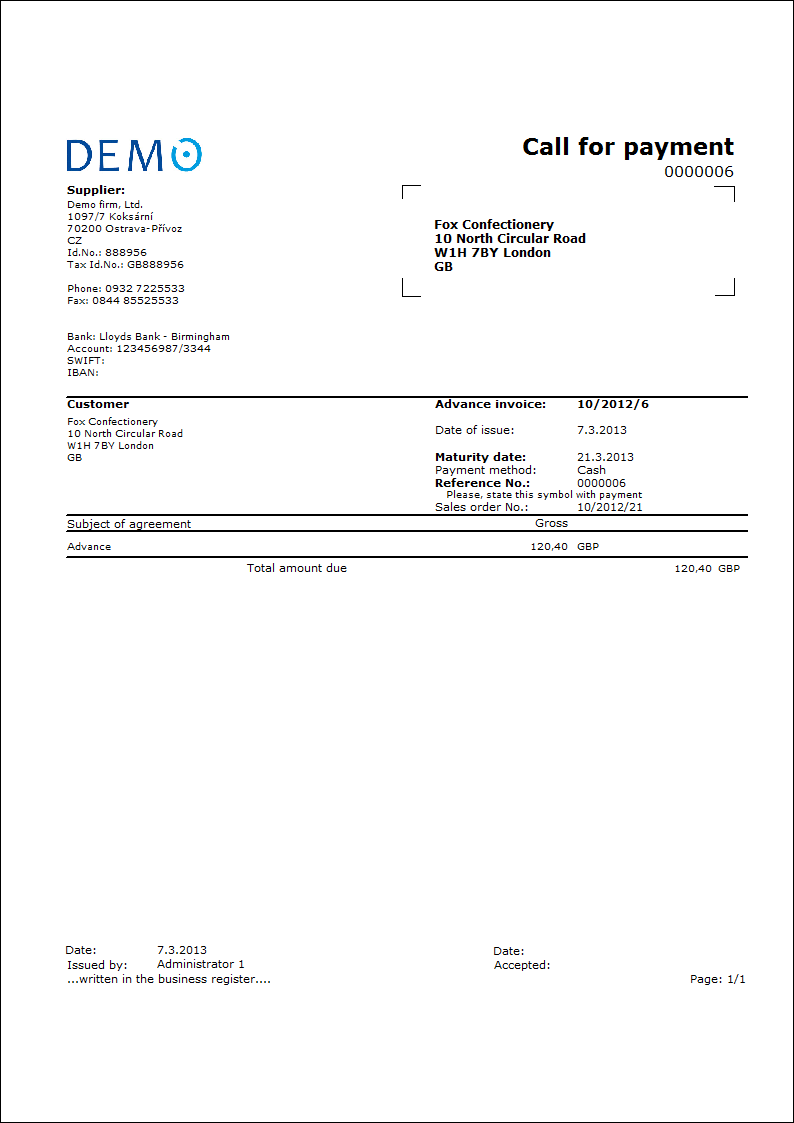
Picture: The printed call for payment
There is an exclamation mark on the 2nd page of a sales order in the header and also next to the "Remain to deduct from adv. to sales order" amount, in the case, if an unpaid or a partially paid advance to sales order exists. If an unpaid or a partially paid advance to customer exists, the exclamation mark will be displayed next to the "Remain to deduct from adv. to customer" amount.
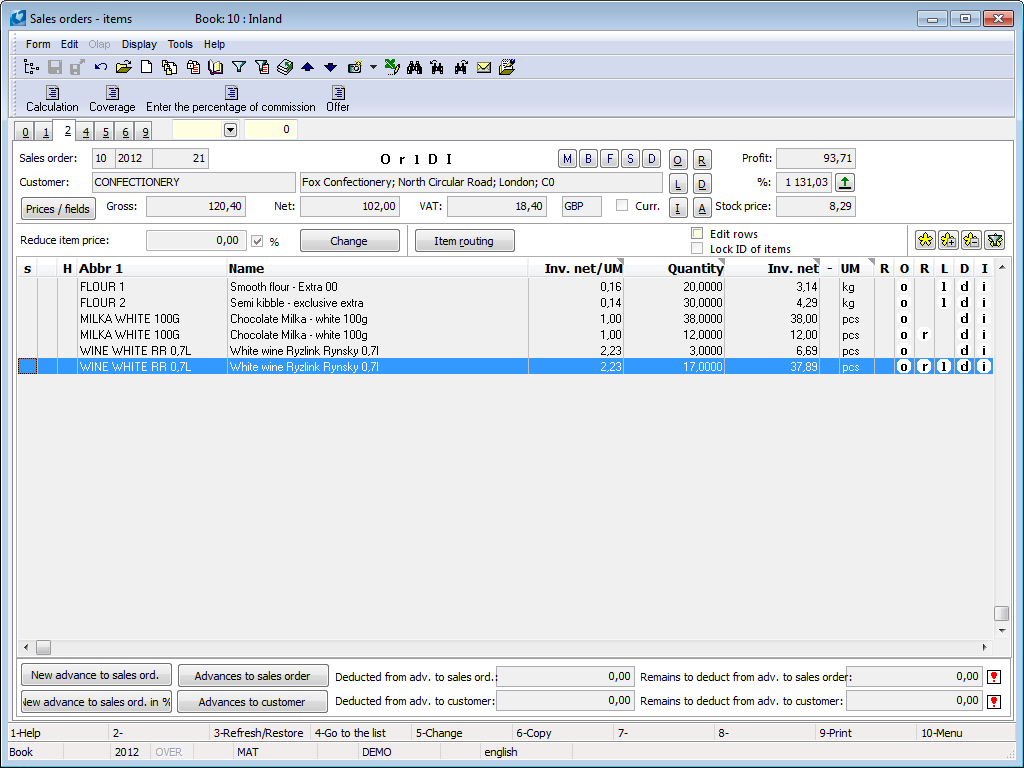
Picture: Sales order - the existence of an unpaid advance
The selections Unpaid advances - for one customer and Unpaid advances - for all customers serve for searching advances, which are not paid. Select a range, in which the Advance date on the documents will be taken into consideration, at both selections. Further, you can select books from that the documents will be selected.
In the IS K2 you enter payment in cash as a cash voucher. If you need to execute payment in cash directly during the creating the call of settlement (see the chapter Call of settlement), you will use the function of an automatic payment on the 6th page of advance received. The function you activate by Shift + F2, in the displayed form you choose a cash, set a date of payment, enter a size of an amount '100 %' and check the field Amount: pay remaining amount. The function automatically creates a cash voucher on amount equal to amount from an advance and the function will align this cash voucher with the advance.
If the payment in cash in time preceded to the creating the call of settlement in the Advance received book, then you would have the cash voucher on a received amount (a cash voucher has to have the type PZ – advance received). Matching the payment on an advance you execute by editing an appropriate cash voucher, you enter a book, a period and a number of a new created advance received.
If the payment of the advance runs by a bank transfer, then the payment of the call of settlement will execute by matching an appropriate item of a bank statement with an advance received. During the automatic matching (by the Ctrl+F3 keys over the bank statement in the Change mode) the automatic selection of an advance according to a reference number or simultaneously according to the amount Pay off is executed. The reference number is entered in the item of a bank statement. When a corresponding advance received is found, the item of the bank statement will automatically change the type to 'PZ - advance received' and to the item of the bank statement the number of the advance received will fill. Hereby the payment will pair to the advance received.
Similarly you can execute matching manually, i.e. in the Change mode of the bank statement you change the type of item to 'PZ – advance received' and choose the concrete advance received.
During the saving the cash voucher of the bank statement which is matched to the advance received the function for the switching the advance received to the state Tax document activates. It will execute when the advance will be totally paid by the payment and in the books of sale the field Set "tax doc." status on advances when paid in full is checked. During the saving the payment of the advance the date of execution of the advance is also automatically changed according to the date of payment.
Every payment of an advance increases an amount that you can deduct on the invoices (the Remains to deduct field on an advance received).
The selections Paid advances - for one customer and Paid advances - for all customers serve for searching the advances, that aren't paid. At both selections you choose a range where the Date of execution will take into consideration in the documents and further you can select the books from which the documents will choose.
The selection Advances not switched to DD serves for the searching the advances which are fully paid, the advances haven't checked the VAT flag and its aren't switched to the "tax document" state. In the selection you can choose a range where the Date of execution will be into consideration in the documents.
The currency of an advance and the currency of a payment are identical
Procedure for advance payment in the client currency is no different from the description in the Received payment chapter.
There is the Copy exch. rate of payment into the advance check mark in the Automatic payment form. If we would to pay an advance, which has an another exch. rate then has a payment and the Copy exch. rate of payment into the advance check mark:
- will be checked - an exchange rate of an advance will be overwritten according to the exchange rate of a payment,
- will not be checked - an exchange rate of an advance will not be changed, the message "Exchange rate of the advance differs from exchange rate of the payment!" will be displayed and a payment will not be saved.
Upon advance payment in the foreign currency, if an Exchange rate of the advance differs from exchange rate of the payment on a cash voucher and a bank statement, these cases may arise:
- Upon manually selection of an advance on the cash voucher or bank statement, the message: "Do you want to change exchange rate of the advance according to the document exchange rate?" will be displayed. After approval this message, the Exchange Rate on the Advance will be automatically changed according to the Exchange Rate of a payment. If you select "No", the message "Exchange rate of the advance differs from exchange rate of the payment!" will be displayed and it will not be possible to save the payment.
- Automatic matching - there is a new checkbox "copy exch. rate of payment into adv." on the "Automatic matching" form when matching a bank statement with a bank order. If we tick the box, the Exchange Rate on the Advance will be changed according to the Exchange Rate on a bank statement when matching. If the field will not be checked, this message will be displayed when matching: "Exchange rate of the advance differs from exchange rate of the payment!". The payment will not be matched.
- When matching by homebanking by using HB - bank statement script, the exch. rate of an advance will be automatically overwritten according to the exch. rate of the payment.
The advance is in the basic currency and the payment is in a foreign currency
- This message will be displayed when manually matching an advance, when editing amounts or exch. rate of payment: "Do you want to adjust the advance amount to payment amount?" After selecting "Yes", the advance will stay in a basic currency and the gross of advance will be calculated according to the payment amount (ie. Payment amount in the currency * exchange rate of a payment), Net and VAT of an advance will be calculated. If you choose "No", a payment will be matched but data on an Advance will not be changed.
- Automatic matching - if the field "Copy exch. rate of payment into adv." is checked, the advance will stay in a basic currency and the gross of advance will be calculated according to the payment amount (ie. Payment amount in the currency * exchange rate of a payment), Net and VAT of an advance will be calculated. If the field is not checked, a payment will be matched but data on an advance will not be changed.
An advance and a payment are in a different foreign currencies (an advance is in a foreign currency and a payment is in a currency of a company)
Data in documents are not changed by matching payment with an advance.
In this case, the Copy exch. rate of payment into the advance checkbox does not work when automatically matching and it is necessary to repair the exch. rate manually (undo match an advance from an item of payment, change exch. rate on advance and again match it with payment). An exchange difference should not be created when payment of an advance. There is "BMAdvCourseDiff" field on the 2nd page of cash vouchers and bank statements and there is "BFAdvCourseDiff" field on the 0th page of advance received and provided. These fields display exclamation mark, if there is an exchange difference on the advance payment:
- if you change an exchange rate of an Advance on the payment and this creates an exchange difference - the exclamation mark will be displayed on the payment and also at an Advance,
- if you change an exchange rate on an Advance and this creates an exchange difference - the exclamation mark will be displayed at an Advance.
From the customer, you have received an amount as an Advance payment. Realize and invoice the Sales Order. The resulting tax document will contain the deduction of the already paid amount.
These situations may occur:
- advance received is equal to the invoiced amount for a complete Sales Order,
- advance received is higher than the invoiced amount for a complete Sales Order,
- and advance received is lower than the invoiced amount for a complete Sales Order.
In the K2 IS, the settlement of the advance is solved by so called deduction of Advance on an Invoice. Deduction of advance reduces the total amount of Invoice by the deducted amount from the Advance. The tax recapitulation will be adjusted by this way. The correct values in the VAT Return will be ensured, however provided that the Tax rate and Tax type have been correctly entered in the Advance Received.
First search out an invoice out. For faster orientation whether an advance to deduct exists to the given invoice out, there are some bitmaps, which inform us about the existence of the non-deducted paid advances, on the 1st and 2nd page in the header of an Invoice:
 they inform the user about the existence of a paid, non-deducted Advance to a Sales Order,
they inform the user about the existence of a paid, non-deducted Advance to a Sales Order, they inform the user about the existence of a paid, non-deducted Advance to a Customer.
they inform the user about the existence of a paid, non-deducted Advance to a Customer.
Switch the selected invoice out to Change mode. Then use either the Apply Adv. linked w. Sales Ord button or the Apply Adv. linked w. Customer button on the 2nd page. The difference between these buttons is that the Apply advance linked with Sales Order is used for a linked invoice out (it has a superior document - a Sales Order) and after pressing the button, the Advances to the identical sales order will be offered. At the multi-invoices, all Advances to all Sales Orders on the Invoice are displayed. Use the Apply Adv. linked w. Customer button for free Invoices (they do not have a superior document - a Sales Order). After pressing this button, the Advances to the customer from the Invoice will be offered. In the both cases, the amounts of Advances for deduction up to maximum amount will be offered.
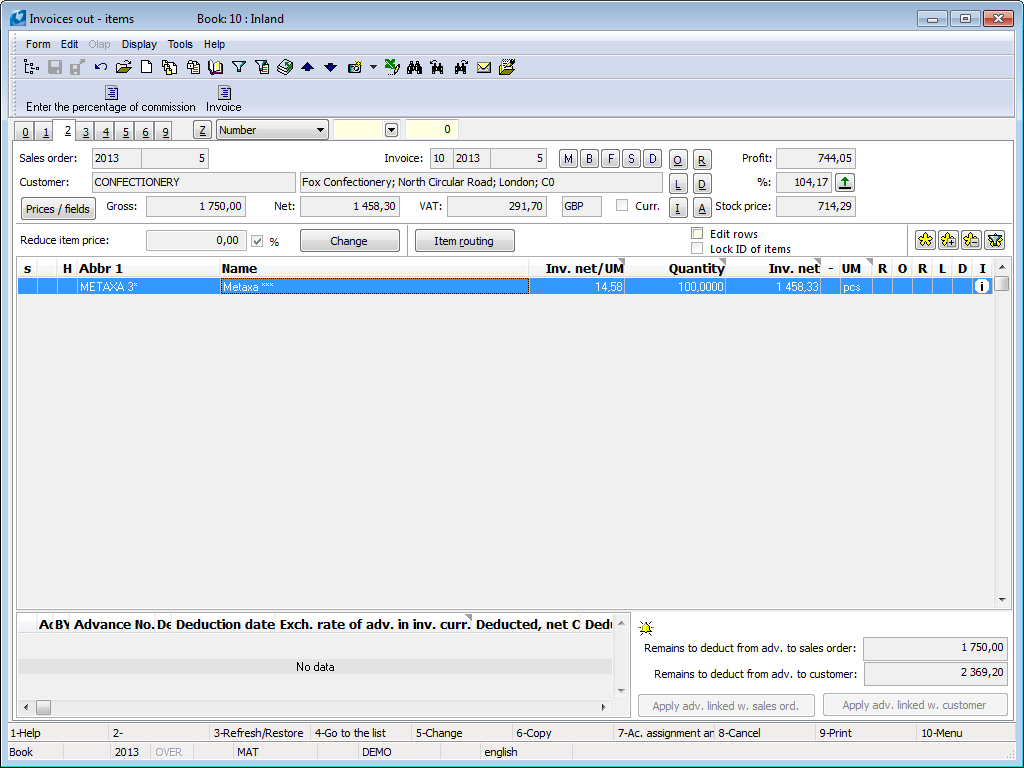
Picture: Invoice Out - 2nd page - button for a deduction of advance
In a displayed list of Advances, the Advances, that are selected to deduct, are indicated by asterisks and the amount of deduction is specified at these (Deduct, Gross column). The User can change deducted amounts, cancel the marking of the Advance or mark another Advances. When the selection of the Advances and the deducted amounts is executed, the deduction is added to the Invoice by the Apply Deduction button or by pressing Ctrl+Enter keys.

Picture: Entering the amount of deduction
In the case that the amount of a Received Advance equates to the total invoicing amount, then the resulting amount of the Invoice after the deduction of advance will be zero.

Picture: Deduction of the Advance in the same amount as the amount of an Invoice
In the case that the amount of the Received Advance is lower than the invoiced amount, then you can deduct the whole Advance on the Invoice. When indicating such an advance, the K2 IS will offer the whole amount of the Invoice but then it depends on a specific situation whether the user will leave the deducted amount in this amount or he/she will decrease it and will not deduct the whole Advance.
After saving the deduction, some amount will remain to pay on the Invoice.
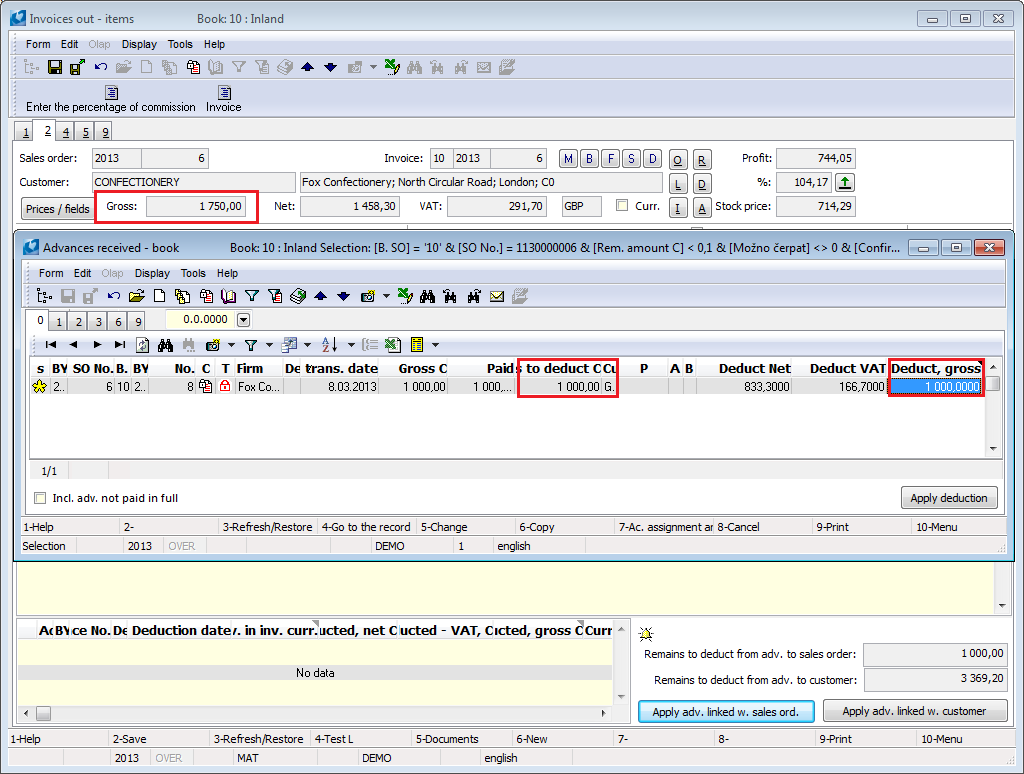
Picture: Deduction of Advance in the lower amount than the value of an Invoice
A list of deducted advances on an Invoice can be easily changed:
- it is possible to add the next deduction of advance by pressing Insert key,
- it is possible to remove a deduction of advance by pressing Del key,
- or it is possible to adjust the deducted amount right in the Deducted, Gross C. column after pressing Enter key (confirm the adjusted amount by pressing the Enter key again).
In the list of deducted Advances, there it is also possible to switch on a particular Advance simply by the Enter key, or by double click on the left mouse button.
It is also possible to specify the amount of deduction in the Deduct net column. The user enters a random Net amount, the Gross amount is calculated according to the VAT coefficient (and according to the VAT and Tax document setting). From this Gross amount, the VAT, which will be rounded according to the client parameters, is calculated. The calculated VAT will be added to the Net amount specified by the user and the sum will be used as "Deduct gross". The result is, that there is what a user entered in the Net and VAT is rounded. The Net amount can be entered only if "VAT from above" is not set.
You can deduct the advances that have been paid in the various currencies. If the currency of the Invoice is different from the currency of the deducted Advance, the amount of deduction will be recalculated according to the currency of the Invoice. The Exchange rate of deduction (it means the exchange rate of the Invoice) will be entered from the Exchange list according to the date of the Advance. If the Exchange list is not regularly actualised and the Exchange rate of the given date is not mentioned, it is necessary to adjust the Exchange rate of deduction manually on the 2nd page in the lower part of the form in the Exch.rate of advance in inv. curr. column.
The Invoices with an Applied Advance - for one supplier (in the K2 IS, it is called as Applied Advances - for 1suppl.) and Invoices with an Applied Advance - for all suppliers (in the K2 IS, it is called as Applied Advances - for all suppl.) selections are used for searching Invoices on which the Advance has been already deducted . For both selections, specify a range in which the Ac. trans. date will be taken into consideration on the documents. Further, you can select books from which the documents will be taken.
Example: Customer will pay cash an advance on delivery of the goods in amount 2 000,- GBP. The goods will be dispatch next day.
You create an advance received on an appropriate customer in amount 2 000,- GBP. As a tax type you enter 'N' (Not to include to the VAT return) and choose a tax rate 'N' or 'NN' (zero VAT rate). An advance received will not have checked the field VAT.
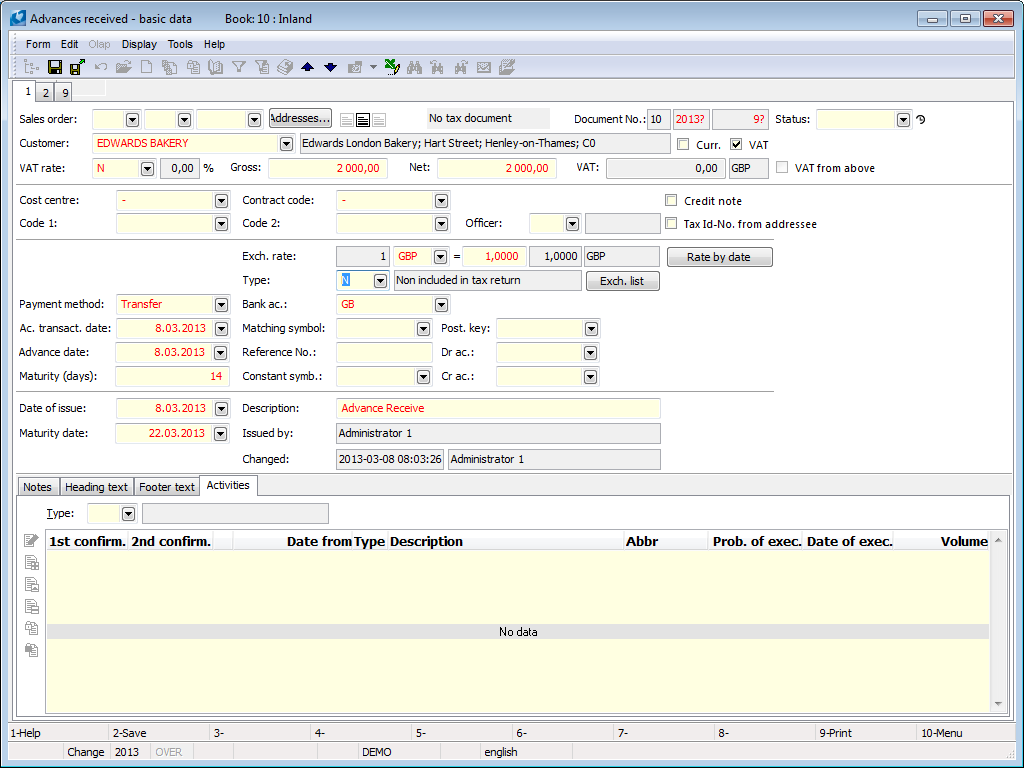
Picture: No tax advance with the tax type "N"
You save an advance, confirm and on the 6th page you execute the payment by cash by Shift + F2. (After payment the advance received will not switch to the tax document state because it hasn't got checked the field VAT.)
After expedition of the goods you issue an invoice and similarly as in the previous case you have to deduct the paid advance. On the 2nd page of the invoice you click by mouse to the lower table and press the Insert key. A list of the advances will display which you can deduct on the invoice. By Shift + Enter keys you mark no tax advance on the amount 2 000,- GBP. In the column Deduct, gross the amount for deducting 2 000,- GBP will automatically display.

Picture: Selection of the advance for deducting the invoice
By pressing the button Save deducting or by key combination Ctrl + Enter you save deducting the advance to the invoice and the invoice still remains in the Change mode. Total amount of the invoice decreased by the deducted advance.
In a tax summary the deducting the advance proved to be as the deducting the no tax advance, i.e. the VAT will be pay from the invoice from the total value of the goods, i.e. regardless on the amount of the prepayment cause the VAT didn't prove to be from it.
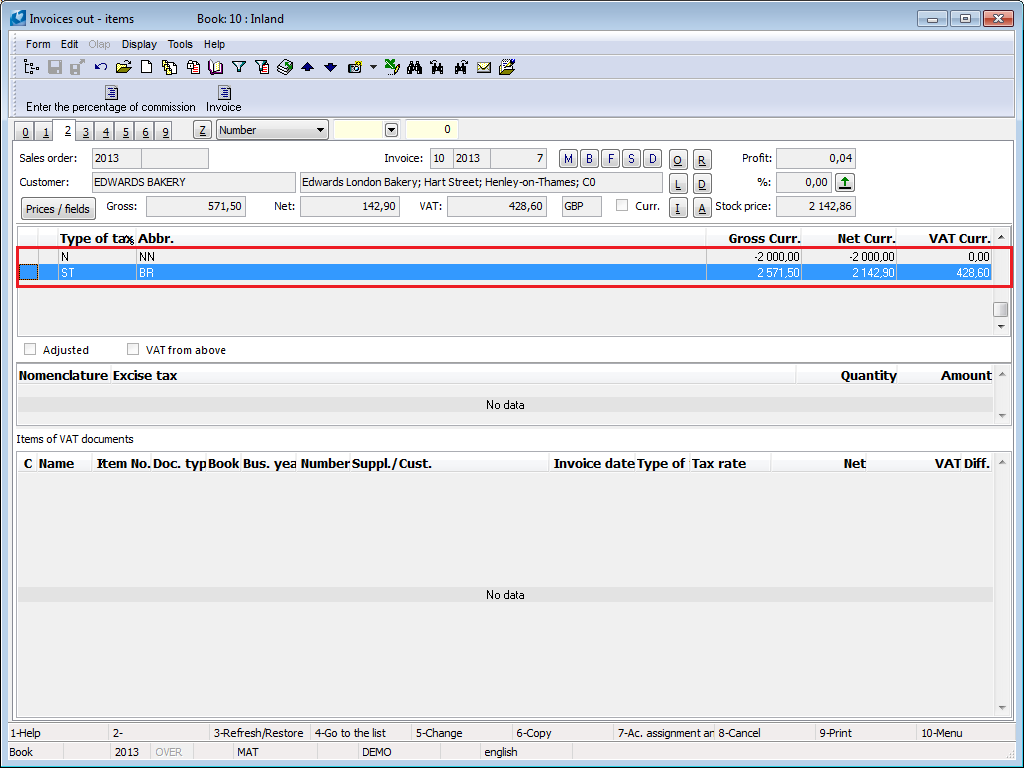
Picture: Tax summary of the invoice for the deducting the no tax advance
You save the invoice, confirm, print and send to the customer.
Advance received contains debit side account and credit side account in a header of the document. Both of the accounts you can pre-fill in the Books of sale. Thus you ensure the filling the debit side and credit side accounts in all new created advances received in an appropriate book. For pre-filling in the Books of sale you select the most frequent accounts for booking na advances received. In case that in an appropriate book you will register an advance that you book to the other accounts, you can change the accounts immediately during the creating an advance or by the bulk action Change posting key (the menu Form - Bulk Actions - Change of posting key) later.
Equally as the accounts you fill the posting key (by which an advance will be booked) to an advance received. You can pre-set a posting key of an advance received in the Books of sale, it is possible to change a pre-set posting key similarly as it is described above at the credit side and debit side accounts, i.e. by the Change posting functions (the Form - Bulk Actions - Change of posting key menu).
Advance received that has got filled a debit side account, credit side account and posting key and simultaneously an advance received is confirmed, is ready for booking.
Advance received is always booked after the payment. Thus you create a filter of the paid advance received per a period in which you want to book the advances and you will bulk-book the advances by standard way (Ctrl+F7 keys over the selected advances).
If the status tax document is change on a booked document, the flags will dropped of booking and liquidation.
Standard you book a tax advance received by this way:
amount net |
debit side account from an advance received / credit side account from an advance received |
100 000 GBP |
amount of VAT |
debit side account from an advance received / 343 |
20 000 GBP |
Standard you book a no tax advance received by this way:
amount gross |
debit side account from an advance received / credit side account from an advance received |
120 000 GBP |
Standard you book an invoice out with the deducting a tax advance by this way:
amount net - performance |
account from an invoice out / income account |
200 000 GBP |
amount net of the deducting from an advance |
credit side account from an advance received / account from an invoice out |
100 000 GBP |
amount of VAT |
account from an invoice out / 343 |
20 000 GBP |
Partly paid/over paid Advance
The Advance that is paid only partly over that is overpaid, is essentially an error condition. Such an Advance should not be invoiced because it is not paid; nevertheless money has been received / paid, so that it is needed accounting. Further you cannot switch such an Advance into the Tax Document status, and therefore it does not enter into the returns of value added tax. From the above it follows that we must solve the wrong Advance status. In the K2 IS there is prepared a function for that.
It is best to perform the checking each month prior to the conclusion of documents for VAT returns or prior financial statements. Activate firstly the selection of Advances that have been paid during the review period but that are not fully paid. The name of the selection is the Underpaid / overpaid Advances.
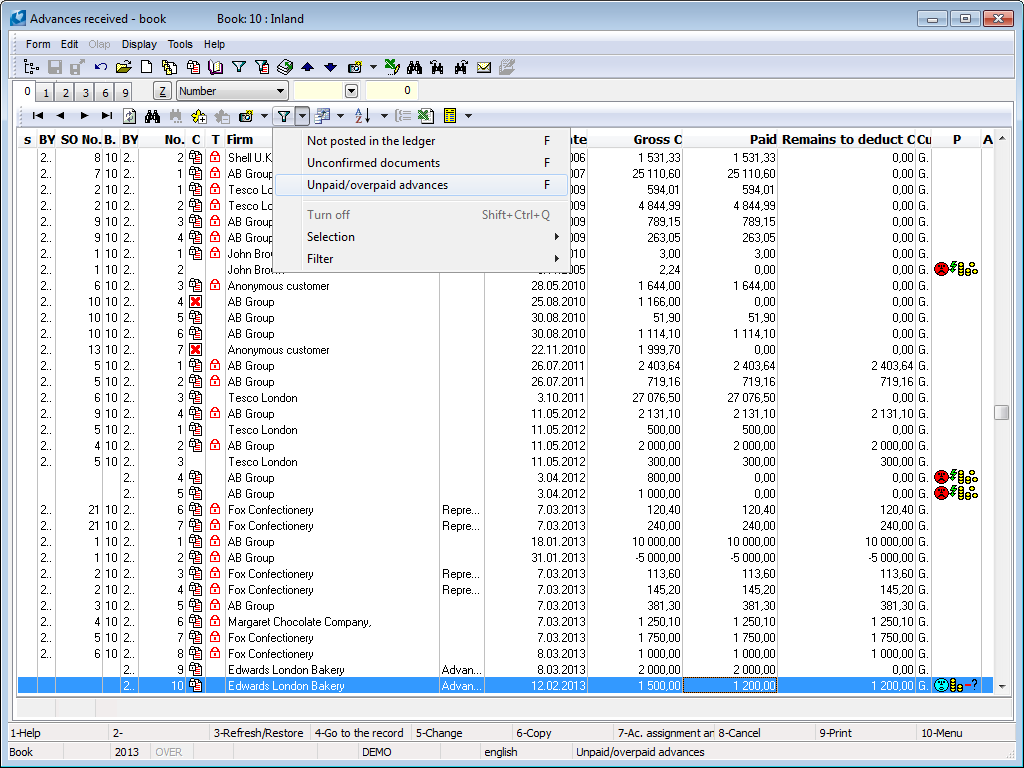
Picture: List of predefined selections

Picture: Form of the Underpaid / overpaid Advances selection
Run the function for each Advance from the Solving incorrect state of the paid Advances filter. You can run this function by pressing the Alt+Shift+F3 keys. It displays a form with choices:
- Divide the Advance into two (the field is accessible only at an underpaid Advance),
- Decrease the amount according to the payment (the field is accessible only at an underpaid Advance),
- Increase the amount according to the payment (the field is accessible only at an overpaid Advance) and
- Set as a Tax Document.
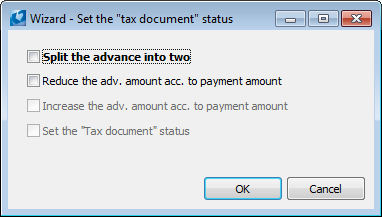
Picture: Form of the Solving of the Incorrect status of paid Advances function
In case of an underpaid Advance, select the first or the second possibility. In case that the Advance will be paid later, select the first possibility (to divide the Advance into two). The Amount of the Advance will be decreased according to the payment and the Advance becomes fully paid. A new Advance of the remaining amount will be created in the same book as the origin Advance.
If you do not expect any further payment in advance, select the second possibility and the amount will be only decreased according to the high of the payment; the Advance becomes fully paid.
In case that the Advance is overpaid, select the third possibility (increase the amount of the Advance according to the payment), that ensures increasing the amount of the Advance according to the high of the payment and the Advance becomes fully paid.
If you check also the Set as Tax Document field at the same time, then after decreasing/increasing the amount of the Advance, when the Advance becomes fully paid, the Advance will be switched into the Tax Document status.
Credit Notes to Advances
Credit Note may be created to an Advance, which is paid and remains to deduct. A new Advance (a Credit Note) with the negative value in the amount of the credited amount will be created to an original Advance. If the advance has more items, a credit note can be created to the items, which remain to deduct.
The Credit notes function (FA_DOB.PAS) is activated over a particular Advance. It is included within the offer of all standard scripts and reports under a Credit Notes keyword. This function is also inserted in the tree menu in the Finance - Functions part.
Example: A new Sales Order for Articles delivery in the value of 100,000 EUR, incl. VAT, is created. An Advance has been received for this Sales Order in the value of 30%, it means 30,000 EUR. After all, the Sales Order has not been realized, it is necessary to issue a Credit note to the Advance Received.
Run the Credit Notes function over an Advance, for which you want to issue a Credit note. An initial form of the function will be displayed.
Indicate the Advance by asterisk in the initial form and move the advance by means of arrows into the bottom part. The amount, which remains to deduct on the Advance, will be automatically predefined. The amount can be edited.
Enter a reason for correction into the Reason for correction field.
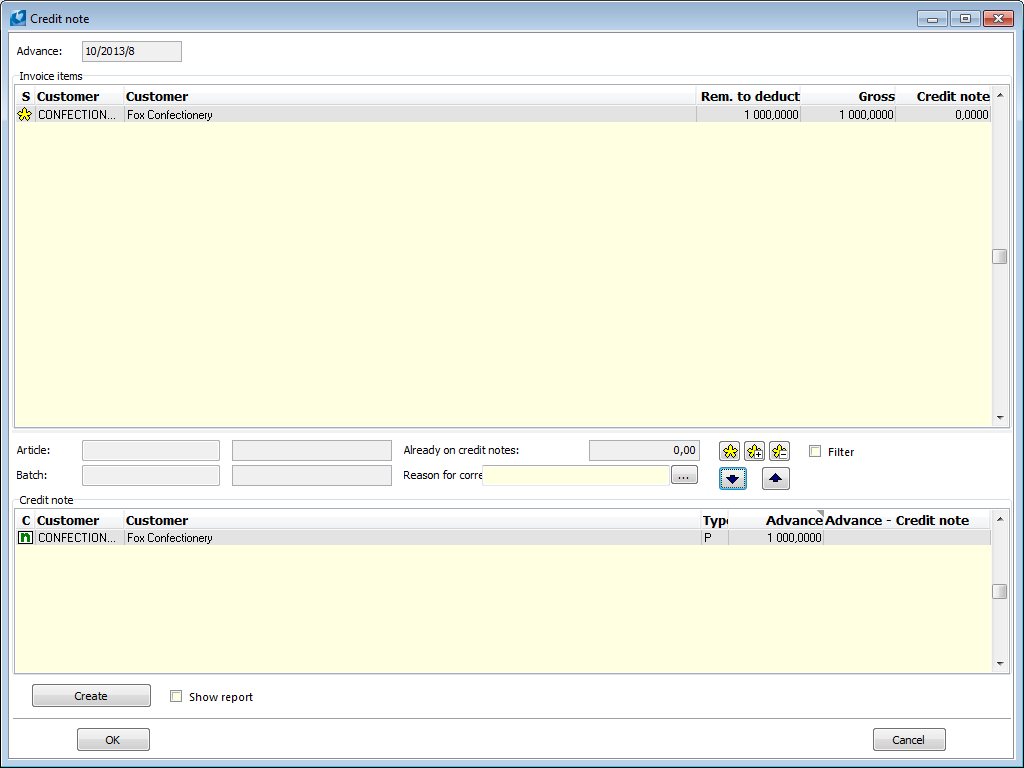
Picture: The Credit notes form with a credited advance
After approving the form, a new advance for the -30,000 EUR with the checked Credit Note field is created and there is a link to the original Advance on its 9th page. A link to the credit note is also inserted on the 9th page of the original advance.
After paying, print the Received Advance report on the advance. If the TaxCreditNoteConfirmation parameter is set on "Yes" in the report, the Confirmation of receipt of credit note is printed within the document as an attachment.
After receiving the confirmation of receipt of credit note from a customer, change the Advance Date on the confirmed Advance by the Shift+F2 key.
After that, run the Mutual Deduction of Advance and Credit Note function. The function is run over a confirmed paid Advance - Credit Note. The mutual deduction can be executed only if the original Advance and the Advance - credit note have:
- the same currency,
- the same exchange rate,
- the same status (tax or non-tax document)
- the same tax rate on items,
- the same tax type on items,
- if the amount on the Advance - Credit Note is not higher than the amount, which remains to deduct, on the original Advance.
If all conditions for deduction will be fulfilled, the mutual deduction of Advance and Advance - Credit note will be executed. The deducted Advance will be displayed on 2nd page on both documents and the "Remain to deduct" values will be recalculated.
To cancel the mutual deduction of Advance and Advance - credit note, you can use the Cancellation of the Mutual Deduction of Advance and Credit Note function.
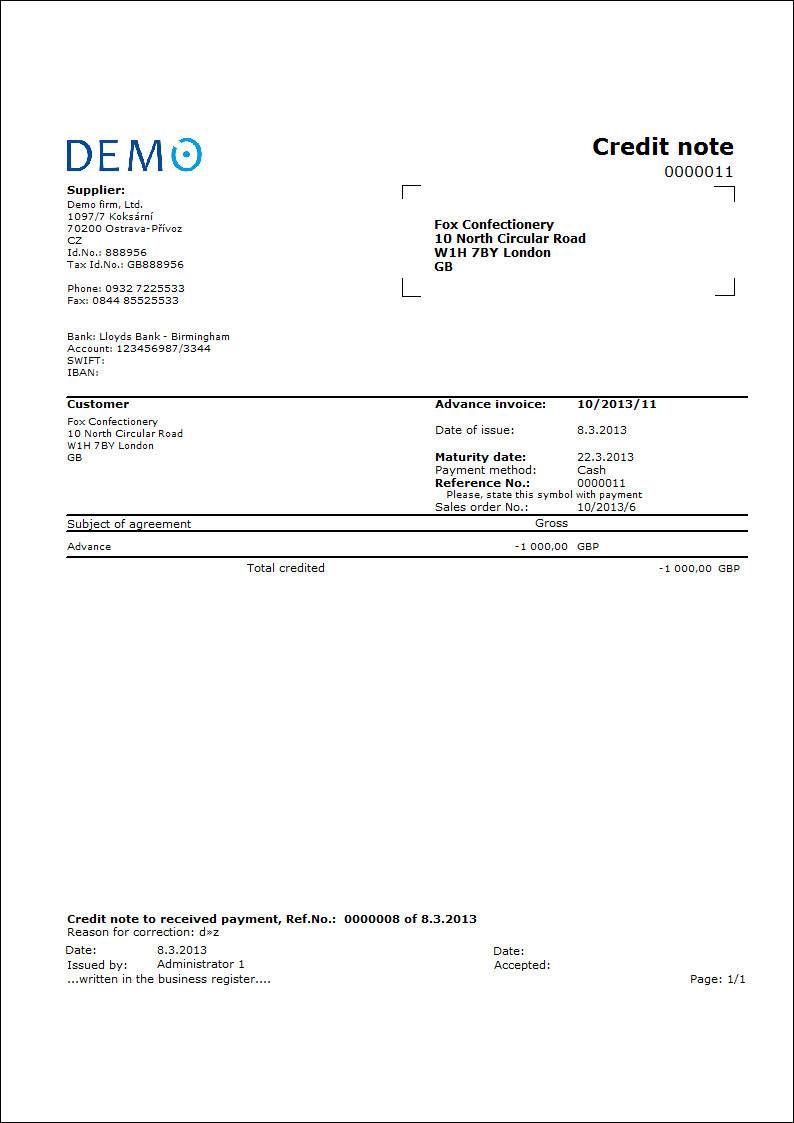
If an advance - credit note is not paid a you want to cancel a document, use the Cancel advance - credit note script. The original advance is offered for deduction.
Credit Notes to revalued Advances
Example: A customer from EU paid on 25/11/2016 advance for goods delivery in the value of 1,000 EUR (exch. rate 0,73 GBP). On 31/12/2016, the advance was revaluated by exch. rate 0,86 GBP / 1 EUR. The goods delivery has not been realized. On 10/1/2017, the advance was returned to customer in full amount, exch. rate of the payment was 0,73 GBP / 1 EUR.
There is an advance from the year 2016, which was revaluated on the date 31/12/2016, in the K2 IS.
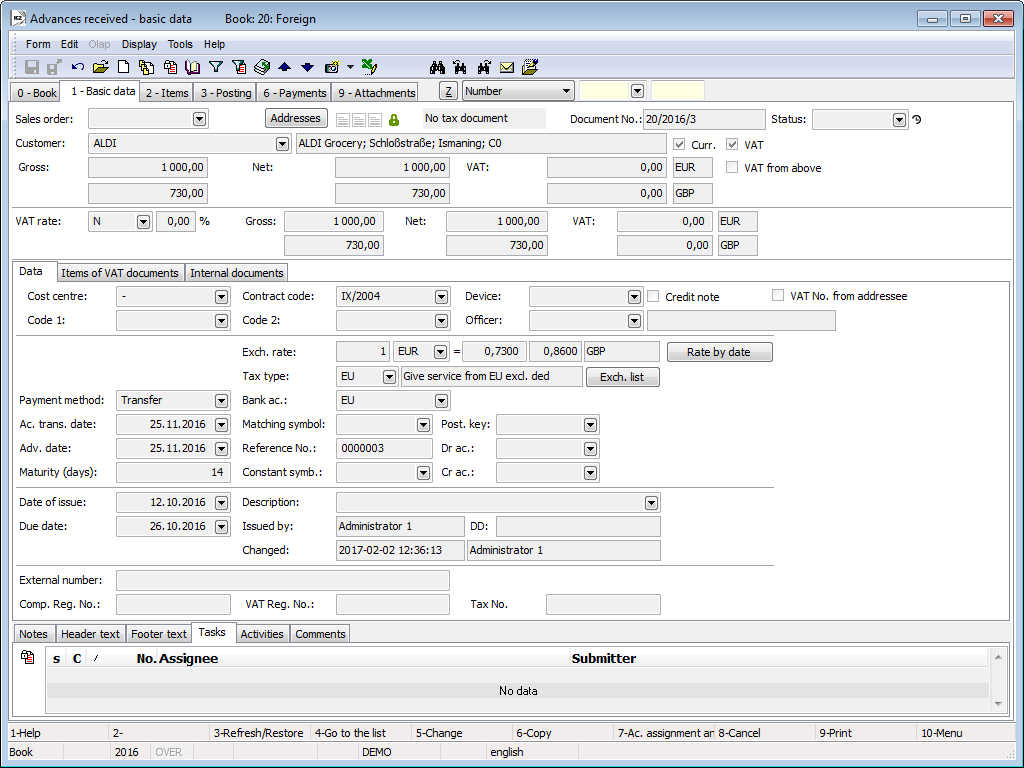
Picture: Advance received - 1st page
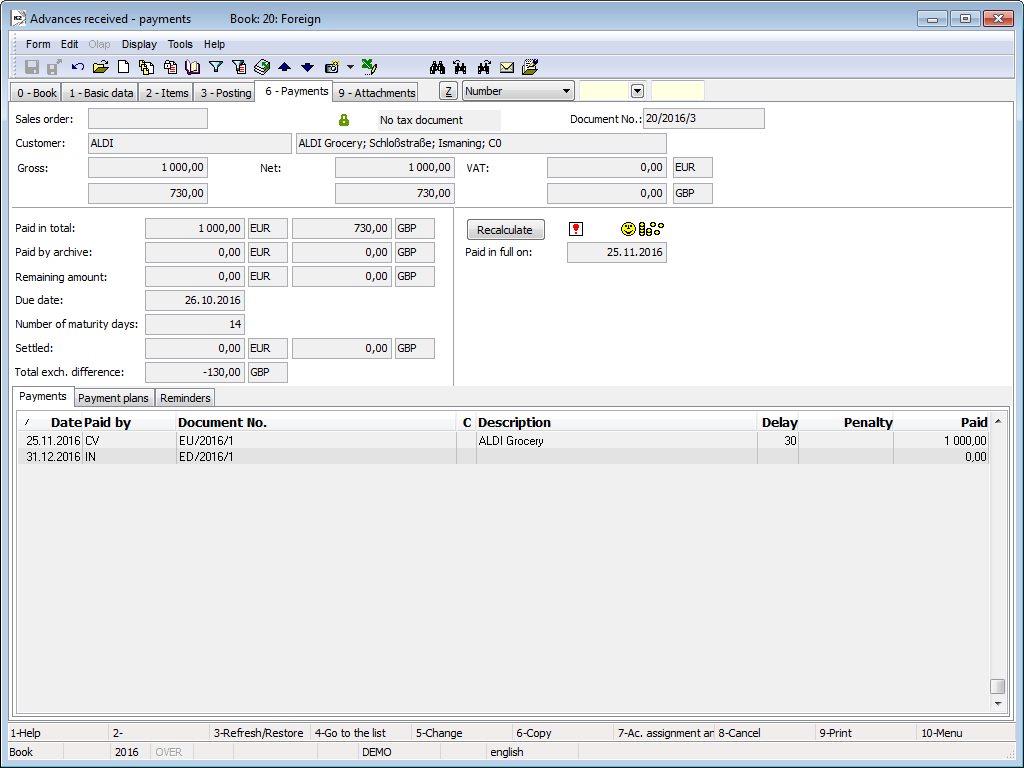
Picture: Advance received - 6th page
By using the Credit note script, create a new advance for -1,000 EUR, exch. rate 0,73 GBP / 1 EUR (exch. rate is identical with the first exch. rate of the advance for which a credit note is created). Pay an advance, exch. rate of a payment is 0,83 GBP / 1 EUR. The exchange rate of an advance - credit note is not changed after paying.
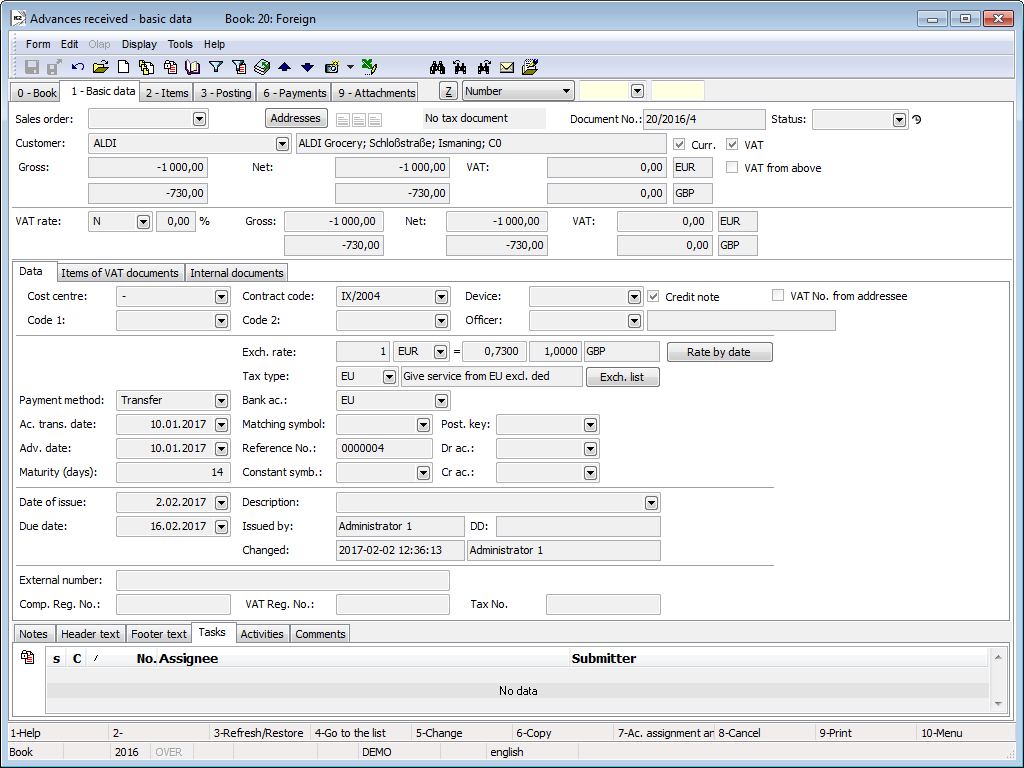
Picture: Advance received - Credit note 1st page
On the paid advance - credit note run the script Mutual deduction of advance and credit note - on the both advances, the amounts Remaining amount will be set to zero.
Posting:
Advance received
Advance received |
324000/324100 |
730 GBP |
Payment of advance received |
221/324000 |
730 GBP |
Revaluation of the advance received on 31/12/2016. |
324100/663 |
130 GBP |
Advance received - Credit note
Advance received - Credit note |
324000/324100 |
730 GBP |
Payment of the advance received - credit note |
221/324000 563/324000 |
830 GBP 100 GBP |
Whereas an exch. rate of an advance - credit note corresponds to the first exch. rate of an advance for which a credit note was created, 130 GBP stay on an account 324100 (amount of a revaluation on 31/12/2016). This amount has to be booked by a general accounting document.
Credit note to advance - change of VAT rate
If a payer or a person, who is identified at the tax and has a duty to declare and pay tax according to an appropriate law of VAT, applied and admitted tax in other way than the law determined, i.e. he/she used other VAT rate and increased tax on output or his/her tax liability, he/she is authorized to execute correction by issuing the credit note. Terms of a credit note are stated in the § 50 law on value added tax.
During issuing a credit note for a payment received, proceed by this way: Firstly create a credit note for the payment received including a wrong VAT rate and then create a credit note as an advance received for the value of an original advance where enter a correct VAT rate. Link the Credit Note with the original Advance Received and with the issued Credit Note on the 9th page.
Example: Demo Firm Ltd. received on 3/ 4/ 2016 an advance of 1,090 GBP for a delivery of goods taxed by basic VAT rate 19%. Delivery will be realized not until next month, therefore an advance received was included to the VAT return per the month April and the company paid the tax on output from it. During the ex post control of VAT it was found that the advance received from 3/ 4/ 2016 has been issued with the incorrect basic VAT rate. Thus issue a credit note for the correction of Vat rate on 20% VAT on the received payment.
Over the advance received from 3/ 4/ 2016 in the amount of 1,090 GBP run the Credit notes script. And further proceed according to a description in the Credit notes to advances chapter.
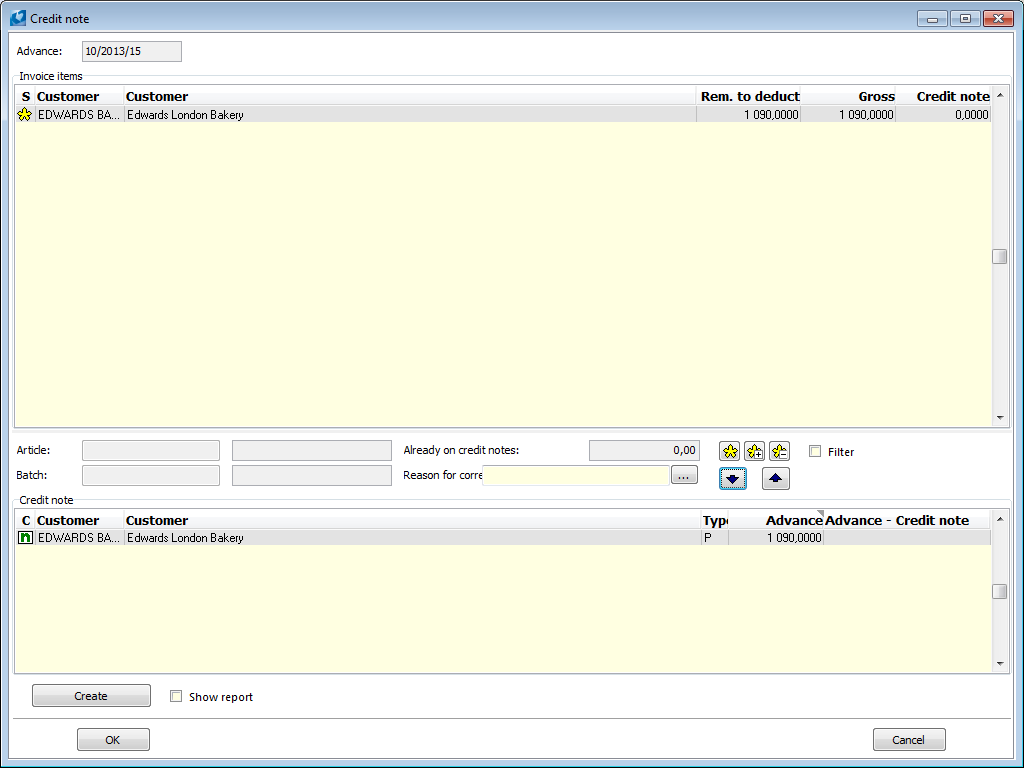
Picture: The running Credit notes script for the repaired Advance Received
A credit note for the full amount of the original advance will be created. The both documents (the original advance and a credit note) will be linked on the 9th page.
In the Advance received book, create a new advance (preferably by copying the original advance), in which you change VAT rate to 20% (gross amount will remain unchanged, net and VAT will be recalculated).

Picture: Copy of the original advance received with the adjusted data - 1st page
Save the advance and add the link to the original advance and to the credit note on the 9th page.

Picture: 9th page of advance received with the link to the original advance and credit note.
In the correction cash register create a cash voucher with the date of correction (date should correspond to the advance date of the original advance). In the cash voucher, create two items which will be the payment of the created documents. The resulting amount of the cash voucher will be zero.
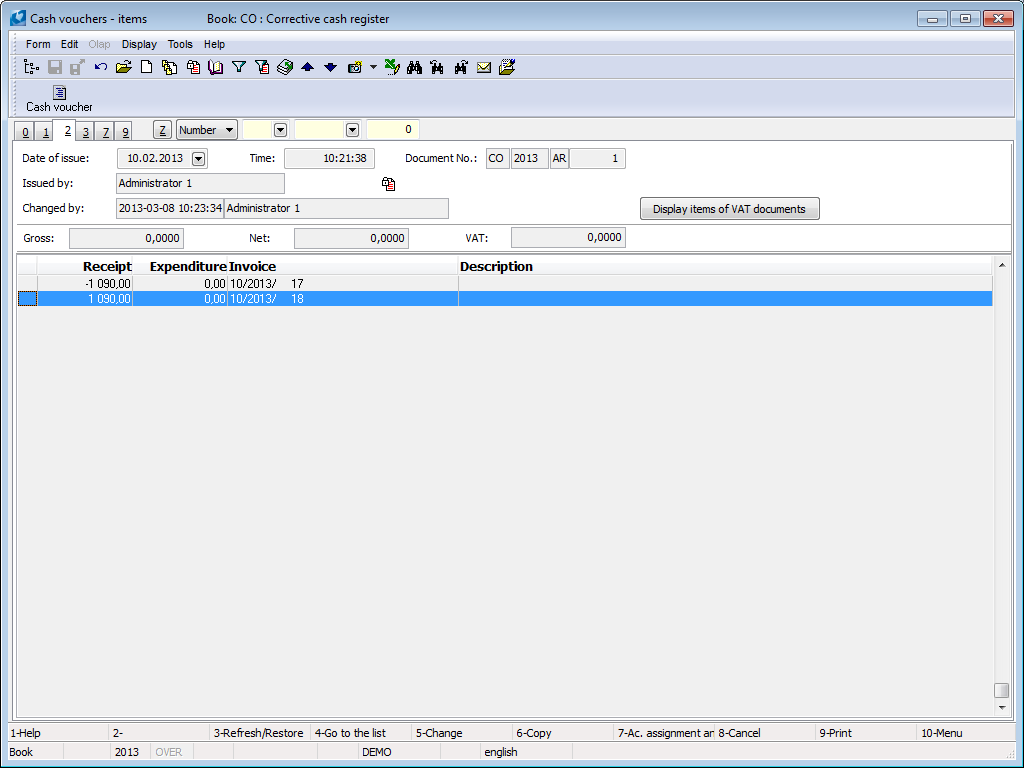
Picture: Cash Voucher
During saving the cash register, the both documents will be automatically switched to the tax document state (if the field Set "tax doc." status on advances when paid in full is checked in the Books of sale), the Adv. date will be changed on the both advances. To the such correction it is necessary to create an Additional VAT return.
Print the Advance Received report with the parameter CorrectionDoc = YES, which will have the formalities of credit note because of the references on the 9th page, from the Advance.
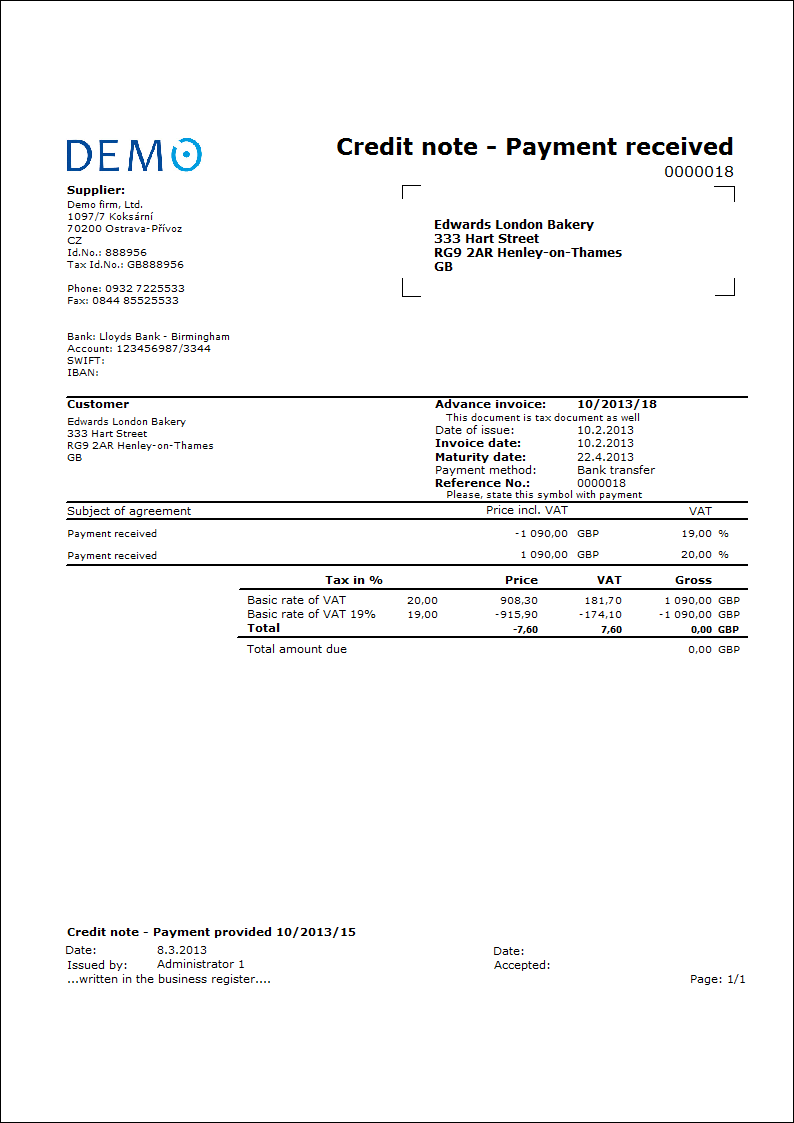
Picture: The printed credit note
Rounding of advances
Upon creating Advances Received in an inland currency from the Sales order, it is possible to set the rounding of Gross depending on the filled Payment method. Rounding is set in the Payment method code list. The value, which should be added or deducted to the rounding number before the rounding (it enables rounding up or down), is entered to the Constant field. To the Order field enter a value to which it should be rounded.
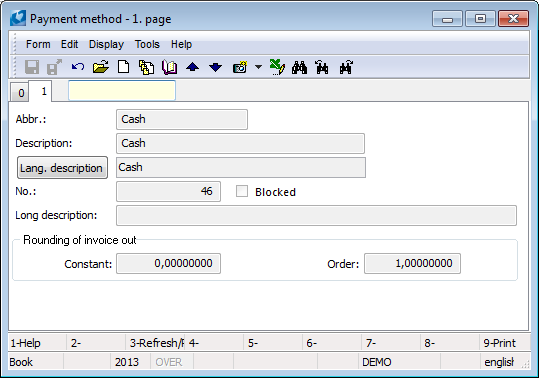
Picture: The Set-up of the rounding for a payment method form
With setting rounding according to the picture a rounding Gross to the integer units will be achieved. Net and VAT are rounded according to the Client parameters.
If the rounding is not set in the Payment method, Gross, Net and VAT of an inland advance are rounded according to the Client parameters.
Gross of an advance in a foreign currency (the Currency option is checked) is rounded depending on setting the rounding of an entered Currency. Net and VAT of an advance in a foreign currency are not rounded.
Rounding is executed during issuing the Advance Received or during changing the Payment method. Rounding difference will be allocated to the first item.